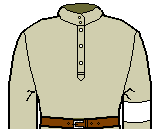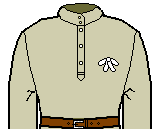
Other Urals Units
Other units attached to the Urals Army.
Urals Artillery
The Urals Host was short of artillery and ammunition for almost its entire existence. A few supplies and trained men did come from KOMUCH and the AFSR when they were in contact.
Most Urals artillery was in the form of horse batteries. There was little or no heavy artillery.
If they followed the WWI pattern, gunners would have worn the standard artillery uniform (see the Don Artillery). We have found no cipher, although "Ур" seems likely if they wore one.
Partisan Units
Partisan units, both cavalry and infantry, were often formed in the Urals area where the Soviets were in control. As with other Hosts, these partisan units were often later integrated into the regular order of battle without significant changes.
If they did not wear standard uniforms, for whatever reason, then markings in anti-Bolshevik forces were often white bands, rosettes or ribbons. Kolchakiya.ru citing the gorynychforum gives units with white deaths heads on the shoulder and with white shoulderboards for specifc partisan units of the Urals Host.
 |
 |
 |
 |
 |
|---|---|---|---|---|
| White sleeve band | White ribbon on chest | Band on furazhka | Rosette on furazhka | Strip on papakha |
Special Detachment for the Liberation of Astrakhan
This was formed in the Guriev area from non-Urals Host men, largely Astrakhan Cossacks and peasants. It is described here.
Although part of the Separate Urals Army and included in its orders of battle, it seems that it fought pretty much independently.
Kirghiz and Kazakhs
The Urals Host attempted to engage the neighbouring Kirghiz into assisting them, largely without huge success. A sotnia or two formed in the Guriev area, but that was about it.
Late in 1917 the Kazakhs and Kirghiz had formed a separatist group called the Alash Orda whose area reached up the southern border of the Urals Host homeland. It was never very organised, but initially it was more or less friendly to the Whites and opposed the Reds. In mid-1919 it shifted to being more sympathetic to the Reds, still without much active participation. A year later it was dissolved completely by the victorious Soviets.
The nomads, while not active, did however protect the Urals from the direct attentions of the Turkestan Soviet forces across their steppe. (The threat from that Soviet was therefore only from a landing in the Caspian.)
Note that the Russians at the time did not much distinguish between Kazakhs and Kirghiz, apparently using the two terms interchangeably. This can make tracking who did what very difficult.
13th Orenburg Cossack Regiment
This unit spent very much the whole war fighting with the Urals Host, apparently in the Iletsk region (that is, where the Urals borders the Orenburg) as part of the 2nd Iletsk Corps.
There seems to be no reason why it would not dress as a normal Orenburg regiment.